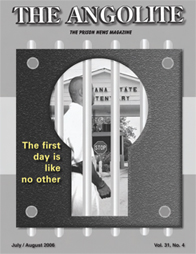Inner Circle
Sullivan still wanted to get beyond the gatekeepers and interview the inner circle. To build her narrative, she needed firsthand accounts of what the prison was like in 1972—specifically on the day of the murder and during the investigation that ensued. It was not easy; in the closed community that made up Angola, word got around quickly. By this point in her reporting, prison officials were tracking Sullivan’s movements and had asked several of those she wanted to interview not to talk to her.
Nonetheless, on a third trip in September 2008, she and her producer—despite the obstacles—finally located people who had been prisoners at Angola at the time of the Miller murder and who agreed to see them. Some spoke only on the condition that Sullivan not identify them by name. The inmates described Black Panther meetings—Wallace and Woodfox were its leaders—behind the prison dorms in 1972, and discussions about starting a revolution in the prison, or to protest the violent conditions at Angola. The Black Panthers were a Marxist revolutionary group formed in 1966 that had several goals, including the release of African-Americans from US jails. The group had numerous chapters across the country.

The
Angolite
.
Courtesy Louisiana State Department of Corrections
Others were willing to speak on the record. Sullivan interviewed Wilbert Rideau, a former prisoner who had been editor of the prison newspaper, Angolite , during the 1970s. The prison had been a violent place. When they met, Rideau showed Sullivan back issues with stories about the 52 men stabbed during 1972, eight of whom died. The previous year, 82 had been stabbed, eight fatally. “Angola was a lawless jungle,” Rideau told Sullivan.
Another interviewee who provided Sullivan with an inside look was Lloyd Hoyle. In the 70s, Hoyle had moved from a position as deputy warden in Iowa to a similar job at Angola. In 1972, he and his boss oversaw the investigation into Miller’s murder. Hoyle told Sullivan that the prison guards, many of whom were illiterate, abused and tortured inmates. Inmates slept with J.C. Penney catalogues strapped to their chests to protect them from stabbings. When Hoyle visited the prison before taking a job there, he was taken aback by the state of affairs at Angola. “I wasn’t even working there, and I almost shed tears because of the conditions of that prison,” he told Sullivan.
While Sullivan felt better about her developing story, there was still a major piece missing. For a fully credible and properly reported story, she needed to talk to Wallace and Woodfox themselves.